
Ramayana is one of the two major Sanskrit epics of ancient India, the other being the Mahābhārata. Along with the Mahābhārata, it forms the Hindu Itihasa.

Kambar was a medieval Tamil Hindu poet and the author of the Ramavataram, popularly known as Kambaramayanam, the Tamil version of the epic Ramayana. Kambar also authored other literary works in Tamil, such as Thirukkai Vazakkam, Erezhupathu, Silaiezhupathu, Kangai Puranam, Sadagopar Anthathi and Saraswati Anthathi.

Ramavataram, popularly referred to as Kamba Ramayanam, is a Tamil epic that was written by the Tamil poet Kambar during the 12th century. Based on Valmiki's Ramayana, the story describes the life of King Rama of Ayodhya. However, Ramavatharam is different from the Sanskrit original in many aspects - both in spiritual concepts and in the specifics of the storyline. This historic work is considered by both Tamil scholars and the general public as one of the greatest literary works in Tamil literature.
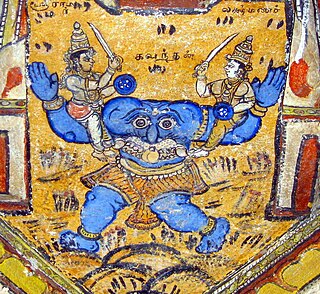
In Hindu mythology, Kabandha is a Rakshasa (demon) who is killed and freed from a curse by the god Rama – an Avatar of Vishnu – and his brother Lakshmana. Kabandha's legend appears in the Hindu epics Ramayana and Mahabharata, as well as in later Ramayana adaptations.

Rama or Ram, also known as Ramachandra, is a major deity of Hinduism. He is the seventh avatar of the god Vishnu, one of his most popular incarnations along with Krishna and Gautama Buddha. In Rama-centric traditions of Hinduism, he is considered the Supreme Being.
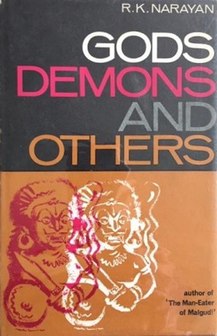
Gods, Demons and Others is a collection of short stories by R. K. Narayan adapted from Indian history and mythology, including epics like The Ramayana and Mahābhārata. In this book, Narayan provides both vitality and an original viewpoint to ancient legends.

The Mahabharata is a mythological book by R. K. Narayan. It is a modernised, shortened and translated retelling of The Mahabharata. It was first published by Heinemann, London in 1978. The book was published as a result of a long endeavour that included three Hindu mythological works, Gods, Demons and Others, The Ramayana and finally The Mahabharata; in 1995, these works were republished as part of a new book, The Indian Epics Retold.
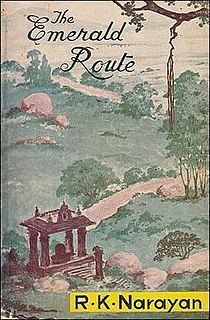
The Emerald Route is a travelogue by R. K. Narayan. It was published by Indian Thought Publications in 1980. It is a pseudo-travel guide for Karnataka, India. The book was commissioned by the Government of Karnataka, and the initial non-commercial version was published in 1977 as part of a government publication. The book is focused on local history, culture and heritage, and doesn't exhibit much of Narayan's characteristic personal narrative.
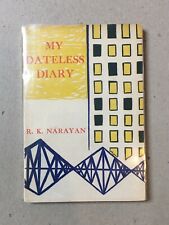
My Dateless Diary is a collection of autobiographical essays by R. K. Narayan published in 1960. The book was the output of a daily journal that he maintained during his visit to the United States on a Rockefeller Fellowship in 1956. While on this visit, Narayan also completed The Guide, the writing of which is covered in this book. The book is focused on Narayan's interactions with the American people and the people themselves. The book also highlights Narayan's view of the west, his appreciation and admiration in general, but subtle disapproval of specific aspects while making it known that there isn't much of a gap between his values and those he has come across. The book offers insights into both, the author and his subjects.

Next Sunday is a collection of weekly essays by R. K. Narayan published in 1960. The book provides insights into Narayan's writings and perspectives and the protagonists of his works - the middle class common man. The book also includes his reflections on the themes of and actions in his novels and short stories.
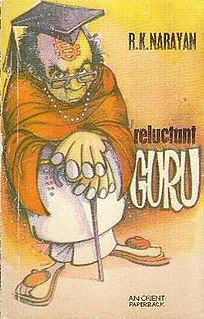
Reluctant Guru is a book by R. K. Narayan published in 1974 by Orient Paperbacks. The book consists entirely of discursive essays, some of which were his weekly contributions to The Hindu. Some of the essays relate to the topic of his American stay, describing with his characteristic irony, the expectations of Americans that he would show them the key to the spiritual life of Indians. One criticism of the book is that the essays were too short and therefore lacking in depth.
A Horse and Two Goats and Other Stories is a collection of short stories by R. K. Narayan, published in 1970 by The Bodley Head. The book is illustrated by R. K. Laxman, Narayan's brother, and includes five stories. The title story is a sly narrative of a business transaction between an American tourist and an Indian goat-herder as the result of an inability to communicate with each other.
Ramayana is one of the two major Sanskrit epics of ancient India.

Ramayana is a retelling of the epic by C. Rajagopalachari. It was first published by Bharatiya Vidya Bhavan in 1957. This book is an abridged English retelling of the Valmiki Ramayana; he had earlier published a version of Kamba Ramayanam. Rajaji considered this book and his Mahabharata to be his greatest service to his countrymen.
Hindu scriptures are classified into two parts: shruti or śruti, meaning what has been heard and smriti, or smṛti, meaning what has been retained or remembered. The Vedas are classified under śruti.

In the Hindu epic Ramayana, Nala is the vanara, who is credited as the engineer of the Rama Setu, a bridge across the ocean between Rameswaram (India) and Lanka, identified with modern-day Sri Lanka, so forces of the god Rama can pass over to Lanka. The bridge is also known as Nala Setu, the bridge of Nala. Sometimes, another vanara called Nila is also credited as the builder of the bridge. Nala is described as the architect of the vanaras. Nala is also described to have fought in the battle between Rama and Ravana, the king of Lanka.
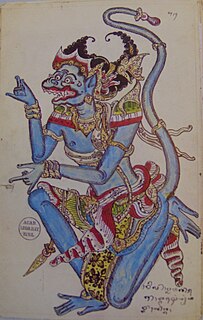
In the Hindu epic Ramayana, Nila is a vanara chieftain in the army of Rama, the prince of Ayodhya and avatar of the god Vishnu. He is the commander-in-chief of the monkey army under the monkey king Sugriva and is described as leading the army in Rama's battle against the rakshasa king Ravana of Lanka and as killing many rakshasas.
P. S. Sundaram (1910–1998) was an Indian professor of English, best known for translating the Tirukkural and various Tamil classics into English. He had degrees in English from the University of Madras and the Oxford University. He served as professor of English for about 40 years in different parts of North India.
Kamban Kazhagam is a Tamil organisation which was founded to promote Ramayana of Tamil poet Kambar. The organisation was formed by Tamil politician Saw Ganesan at Karaikudi in 1939.


















